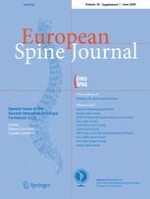Published in:

01-06-2009 | Original Article
Two-level total lumbar disc replacement
Authors:
Mario Di Silvestre, Georgios Bakaloudis, Francesco Lolli, Francesco Vommaro, Patrizio Parisini
Published in:
European Spine Journal
|
Special Issue 1/2009
Login to get access
Abstract
Total lumbar disc replacement (TDR) has been widely used as a treatment option for 2-level symptomatic degenerative disc disease. However, recent studies have presented conflicting results and some authors concluded that outcome deteriorated when disc replacement was performed bisegmentally, with an increase of complications for bisegmental replacements in comparison with monosegmental disc arthroplasty. The goal of the present retrospective study is to investigate results in a group of patients who have received bisegmental TDR with SB Charitè III artificial disc for degenerative disc disease with a minimum follow-up of 3 years, and to compare the results of 2-level disc replacement versus 1-level patients treated with the same prosthesis. A total of 32 patients had at least 3-years follow-up and were reviewed. The average age of the patients was 38.5 years. There were 11 males and 21 females. About 16 patients received 2-level TDR (SB Charitè III) and 16 received 1-level TDR (SB Charitè III). Both radiographic and functional outcome analysis, including patient’s satisfaction, was performed. There were no signs of degenerative changes of the adjacent segments in any case of the 2- or 1-level TDR. There was no statistically significant difference between 2- and 1-level TDR both at 12 months and at 3-years follow-up on functional outcome scores. There was a statistically insignificant difference concerning the patients satisfaction between 1- and 2-level surgeries at the last follow-up (P = 0.46). In the 2-level TDR patients, there were 5 minor complications (31.25%), whereas major complications occurred in 4 more patients (25%) and required a new surgery in 2 cases (12.5%). In the 1-level cases there were 2 minor complications (12.5%) and 2 major complications (12.5%) and a new revision surgery was required in 1 patient (6.25%). In conclusion, the use of 2-level disc replacement at last follow-up presented a higher incidence of complications than in cases with 1-level replacement. At the same time it was impossible to delineate a clear difference in evaluating the questionnaires between the follow-up results of patients receiving 2- and 1-level TDR: the 2-level group presented slightly lower scores at follow-up, but none was statistically significant.